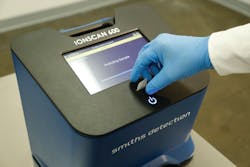Smiths Detection launches new portable trace explosives detector
Ask any aviation security professional to make a list of the biggest threats facing their industry and near the top of almost all of those lists will be the potential of explosives being smuggled onto a jetliner. Just last week, Sen. Carl Levin (D-Mich.), chairman of the Senate Armed Services Committee, told reporters that an al Qaida-linked group was close to being able to develop an explosive device that could go undetected through airport security. Although these threats may be growing in their level of sophistication, so to are the technologies that are being developed to stop them.
Smiths Detection on Monday launched a new, portable trace explosives and narcotics detector called the IONSCAN 600 that is designed to provide airports and users in other vertical markets with a simple and cost-effective method of screening for a wide range of explosives and drugs.
According to James Viscardi, vice president of sales and business development for Smiths Detection, the IONSCAN 600, which weighs just 23 pounds, provides the same level of performance and functionality of the IONSCAN 500 in a much smaller form factor.
“The main new feature of the IONSCAN 600 is its non-radioactive, Ion Mobility Spectrometry or IMS source. It’s proprietary and one of the main value propositions is that it eliminates the need for any kind of special handling, disposal or special licensing to move this thing around the country, much less around the world,” said Viscardi. “It is one of the only non-rad, IMS-sourced systems on the market, which makes it very attractive for customers to buy these in the U.S. and deploy them globally."
Because of its smaller footprint and portable design, Viscardi said that it can be picked up and moved from one location to another very easily.
“It is meant to be used while sitting on a surface, but can be picked up and moved. It comes with a handle so that you can carry it easily from one location to the next and it has a hot-swappable battery that provides for continued sampling and analysis,” explained Viscardi. “With the current units on the market, I have to unplug it, move it, plug it in, wait for it to start up, and go through verification, but I don’t have to do that with this system. I can just pick it up, move it and I can even continue to screen using the battery if I want to, which is something new to the industry.”
Additionally, Viscardi said that the IONSCAN 600 uses much cheaper swabs, which cuts the costs of using the unit over the course of a year by about half. The price point for the unit is also about 30 percent lower than some of the company’s other products, according to Viscardi. “It’s lighter, it’s faster, it’s more flexible, and it’s cheaper,” he said.
Viscardi said that the IONSCAN 600 is currently undergoing testing by the Transportation Security Administration and could be a direct substitute for any other security checkpoint or luggage screening unit the agency is currently using. “Once certified, they could take this unit, plug it right in for that, one-for-one, and it will perform the same function,” he said.
In the air cargo market, Viscardi said use of the IONSCAN 600 would actually be an improvement on the technology they currently have in place because they can pick it up and move it around to accommodate the cargo being screened rather than doing it the other way around.
“When (screening) technology first came out, it was usually based in a big box that you put on somebody’s table, desk or somewhere close to a checkpoint and you had to bring subjects to it. Over the years, the units have gotten smaller, they’ve gotten faster in terms of analysis and processing time, and the levels of detection have improved,” said Viscardi. “In addition to that, we’ve seen an expansion of the types of substances our customers are trying to find – homemade explosives, different kinds of narcotics and designer drugs – and so we’ve expanded the functionality of our system to be able to detect and identify those types of things. Our system, from the very beginning, has evolved with those needs and we will continue to evolve because we design these things with customer input and focus.”
About the Author
Joel Griffin
Editor-in-Chief, SecurityInfoWatch.com
Joel Griffin is the Editor-in-Chief of SecurityInfoWatch.com, a business-to-business news website published by Endeavor Business Media that covers all aspects of the physical security industry. Joel has covered the security industry since May 2008 when he first joined the site as assistant editor. Prior to SecurityInfoWatch, Joel worked as a staff reporter for two years at the Newton Citizen, a daily newspaper located in the suburban Atlanta city of Covington, Ga.

